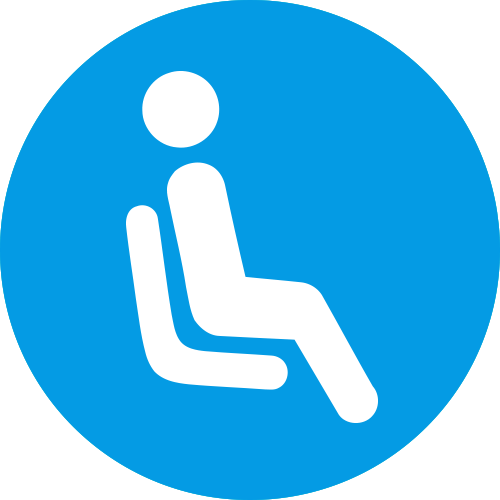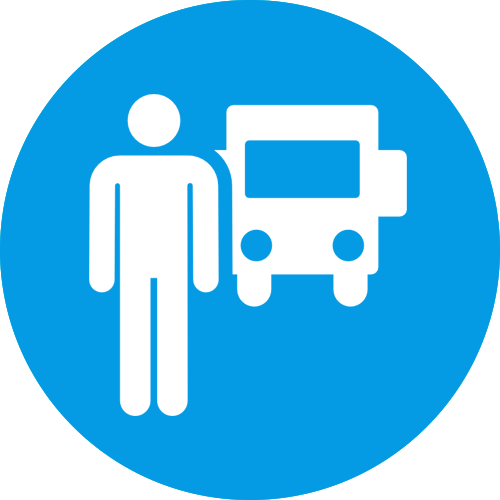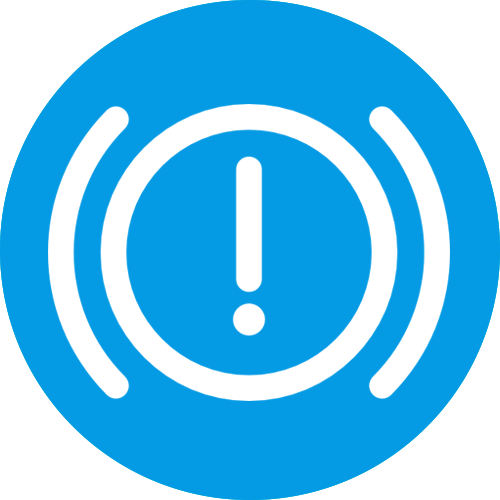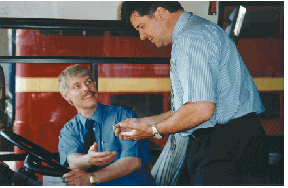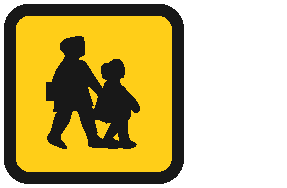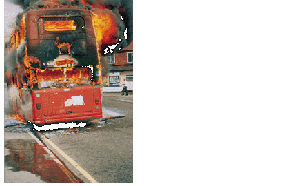There are 69 PCV theory test Carrying Passengers questions. You must get 85% (59 out of 69) to pass the test. You may review answers after each question by clicking the 'check answer' button or you can wait until the end of the test for your final score. Good luck!
PCV Theory Test Categories (2025)
Test Quick View
Click question box to reveal the correct answer. You can print these questions out by clicking the printer icon.
Correct Answer: D
Explanation: Your passengers should be your first consideration. It's your responsibility to deliver them to their destination safely and on time. You should also treat passengers courteously at all times.
Explanation: Your passengers should be your first consideration. It's your responsibility to deliver them to their destination safely and on time. You should also treat passengers courteously at all times.
Correct Answer: C
Explanation: At bus stops, stop close to the kerb, where it's safe and convenient for your passengers to get on and off. Accelerating as you move off can easily unsteady a passenger. Try to wait until all passengers are seated or settled before moving off.
Explanation: At bus stops, stop close to the kerb, where it's safe and convenient for your passengers to get on and off. Accelerating as you move off can easily unsteady a passenger. Try to wait until all passengers are seated or settled before moving off.
B
C
D
Correct Answer: B
Explanation: Operators often publicise journeys as being comfortable, convenient and fast. You play an important part in delivering this standard of service.
Explanation: Operators often publicise journeys as being comfortable, convenient and fast. You play an important part in delivering this standard of service.
Correct Answer: A
Explanation: Your first duty is to your paying customers, who want to reach their destination comfortably and safely. Harsh braking can cause your passengers to be thrown forward on the bus, so avoid this by looking and planning well ahead. Give yourself plenty of time to react to traffic situations.
Explanation: Your first duty is to your paying customers, who want to reach their destination comfortably and safely. Harsh braking can cause your passengers to be thrown forward on the bus, so avoid this by looking and planning well ahead. Give yourself plenty of time to react to traffic situations.
Correct Answer: A
Explanation: When approaching hazards or bus stops, you should always be aware of how your passengers will be affected by the change in speed. Late, harsh braking as passengers leave their seats can take them by surprise and cause them to fall towards the front of the bus, possibly injuring themselves or others. Wherever possible, avoid harsh braking by planning ahead, giving yourself time to reduce speed smoothly.
Explanation: When approaching hazards or bus stops, you should always be aware of how your passengers will be affected by the change in speed. Late, harsh braking as passengers leave their seats can take them by surprise and cause them to fall towards the front of the bus, possibly injuring themselves or others. Wherever possible, avoid harsh braking by planning ahead, giving yourself time to reduce speed smoothly.
Correct Answer: B
Explanation: Always look well ahead. Early planning and anticipation will help you avoid the need to brake harshly. It's important that you give your passengers a smooth journey, especially if any of them are having to stand.
Explanation: Always look well ahead. Early planning and anticipation will help you avoid the need to brake harshly. It's important that you give your passengers a smooth journey, especially if any of them are having to stand.
Correct Answer: A
Explanation: A smooth ride at all times isn't always easy to achieve. However, scanning ahead for hazards will help you avoid late braking and cornering too fast.
Explanation: A smooth ride at all times isn't always easy to achieve. However, scanning ahead for hazards will help you avoid late braking and cornering too fast.
8. Well ahead of you are traffic lights on green. What should you do in case the lights change to red?
Mark one answer
B
C
D
Correct Answer: D
Explanation: If you're approaching a set of traffic lights and you can see they've been on green for a while, be prepared for them to change. Ease off the accelerator and be ready to come to a gradual stop if you need to. Don't try to beat the red light; it may change as you come closer, causing you to brake late and harshly. Think of your passengers.
Explanation: If you're approaching a set of traffic lights and you can see they've been on green for a while, be prepared for them to change. Ease off the accelerator and be ready to come to a gradual stop if you need to. Don't try to beat the red light; it may change as you come closer, causing you to brake late and harshly. Think of your passengers.
Correct Answer: B
Explanation: Passengers are very vulnerable when they're standing in a moving vehicle. Inconsiderate use of the footbrake can easily cause them injury - especially if they're young or infirm. Some passengers may not wait until you've stopped before leaving their seat. If you seem to be in a hurry, they may even leave their seat early because they don't want to feel responsible for holding you up.
Explanation: Passengers are very vulnerable when they're standing in a moving vehicle. Inconsiderate use of the footbrake can easily cause them injury - especially if they're young or infirm. Some passengers may not wait until you've stopped before leaving their seat. If you seem to be in a hurry, they may even leave their seat early because they don't want to feel responsible for holding you up.
Correct Answer: C
Explanation: Turning corners or travelling around bends too quickly will push passengers towards the outside of the bend. In addition, the weight of the passengers being transferred to one side of the vehicle will make the bus even more unstable. This will make steering out of the bend more difficult.
Explanation: Turning corners or travelling around bends too quickly will push passengers towards the outside of the bend. In addition, the weight of the passengers being transferred to one side of the vehicle will make the bus even more unstable. This will make steering out of the bend more difficult.
Correct Answer: D
Explanation: Thinking and planning well ahead will help you to deal competently and safely with hazards and other road users. A safe, comfortable ride, even when you're under pressure, will be appreciated by your passengers.
Explanation: Thinking and planning well ahead will help you to deal competently and safely with hazards and other road users. A safe, comfortable ride, even when you're under pressure, will be appreciated by your passengers.
Correct Answer: B
Explanation: Check your nearside external and internal mirrors before you move away, in case anyone is attempting to board or leave your vehicle. Always give passengers time to be seated safely before you move away.
Explanation: Check your nearside external and internal mirrors before you move away, in case anyone is attempting to board or leave your vehicle. Always give passengers time to be seated safely before you move away.
Correct Answer: A
Explanation: As the driver of a bus, you may be responsible for several passengers at any given time. If a situation occurs where you have to brake or steer harshly, your passengers could be thrown about the vehicle. In these circumstances, there's a significant risk of injury from fittings on board, such as luggage racks, handrails and poles. If seat belts are provided for passengers, they should wear them.
Explanation: As the driver of a bus, you may be responsible for several passengers at any given time. If a situation occurs where you have to brake or steer harshly, your passengers could be thrown about the vehicle. In these circumstances, there's a significant risk of injury from fittings on board, such as luggage racks, handrails and poles. If seat belts are provided for passengers, they should wear them.
Correct Answer: B
Explanation: Every bus must carry a fire extinguisher. Make sure that you know where it's located and how to use it, so that you're fully prepared in the event of a fire.
Explanation: Every bus must carry a fire extinguisher. Make sure that you know where it's located and how to use it, so that you're fully prepared in the event of a fire.
Correct Answer: C
Explanation: It's essential to know the location of first-aid equipment, the fuel cut-off device and the fire extinguisher on every bus that you drive. Take time to familiarise yourself with their location whenever you drive a different vehicle. When you take your PCV test, you'll be asked questions on safety.
Explanation: It's essential to know the location of first-aid equipment, the fuel cut-off device and the fire extinguisher on every bus that you drive. Take time to familiarise yourself with their location whenever you drive a different vehicle. When you take your PCV test, you'll be asked questions on safety.
16. A passenger is boarding your bus. What does it mean if they're carrying a white stick with a red ring painted on it?
Mark one answer
B
C
D
Correct Answer: D
Explanation: A person carrying a white stick or a long white cane may be visually impaired. If the stick has a red ring or red-and-white checks painted on it, they also have impaired hearing. Be prepared to help if they appear to need it, or if they ask for assistance.
Explanation: A person carrying a white stick or a long white cane may be visually impaired. If the stick has a red ring or red-and-white checks painted on it, they also have impaired hearing. Be prepared to help if they appear to need it, or if they ask for assistance.
Correct Answer: A
Explanation: Nobody likes to be late, but you shouldn't let the pressure of your timetable make you feel you have to rush people. Being pleasant to your passengers and showing them some common courtesies will encourage them to use your service again.
Explanation: Nobody likes to be late, but you shouldn't let the pressure of your timetable make you feel you have to rush people. Being pleasant to your passengers and showing them some common courtesies will encourage them to use your service again.
Correct Answer: A
Explanation: You're a representative of your company, so showing passengers that their custom is appreciated will encourage them to travel with you again.
Explanation: You're a representative of your company, so showing passengers that their custom is appreciated will encourage them to travel with you again.
B
C
D
Correct Answer: C
Explanation: Passengers who are hard of hearing may want to lip read. Make sure that they're able to see your face clearly when you speak to them.
Explanation: Passengers who are hard of hearing may want to lip read. Make sure that they're able to see your face clearly when you speak to them.
Correct Answer: A
Explanation: A kneeling bus uses air suspension to lower the front entrance, giving easier access for passengers. This is especially helpful for people who have difficulty climbing steps, are disabled or use wheelchairs. Make sure you're properly trained to use this equipment.
Explanation: A kneeling bus uses air suspension to lower the front entrance, giving easier access for passengers. This is especially helpful for people who have difficulty climbing steps, are disabled or use wheelchairs. Make sure you're properly trained to use this equipment.
Correct Answer: C
Explanation: If you're carrying children on your vehicle and it isn't on a scheduled route used by the general public, the bus must display this sign to the front and rear. When carrying children to and from school, it's likely that you'll have to make several stops in places other than recognised bus stops. Think carefully before you stop. Don't cause unnecessary inconvenience to other road users.
Explanation: If you're carrying children on your vehicle and it isn't on a scheduled route used by the general public, the bus must display this sign to the front and rear. When carrying children to and from school, it's likely that you'll have to make several stops in places other than recognised bus stops. Think carefully before you stop. Don't cause unnecessary inconvenience to other road users.
22. You're driving a bus displaying this sign. When can you use its hazard warning lights?
Mark one answer
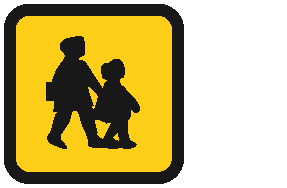
B
C
D
Correct Answer: B
Explanation: You may be driving in the rush hour, when traffic is heavy, so when you stop you're permitted to show your hazard warning lights. This will tell other road users that children are getting on and off the bus. Look out for passing traffic and make sure that all your passengers get on and off safely.
Explanation: You may be driving in the rush hour, when traffic is heavy, so when you stop you're permitted to show your hazard warning lights. This will tell other road users that children are getting on and off the bus. Look out for passing traffic and make sure that all your passengers get on and off safely.
23. Your bus has broken down at night. Why should you move your passengers to the front of the bus?
Mark one answer
B
C
D
Correct Answer: D
Explanation: Passenger safety should be your priority. You should take every precaution to ensure they're out of danger.
Explanation: Passenger safety should be your priority. You should take every precaution to ensure they're out of danger.
24. What should you do when you're driving a coach at night and you have passengers on board?
Mark one answer
B
C
D
Correct Answer: B
Explanation: Passengers should be able to move about the vehicle in safety. You should make sure that all interior lights are in working order before you start your journey.
Explanation: Passengers should be able to move about the vehicle in safety. You should make sure that all interior lights are in working order before you start your journey.
Correct Answer: A
Explanation: Fire can spread extremely quickly. Your priority is the safety of your passengers: you must get them off the bus straight away. If at all possible, disconnect electrical lines and cut off the fuel supply. Fire can destroy a vehicle very quickly.
Explanation: Fire can spread extremely quickly. Your priority is the safety of your passengers: you must get them off the bus straight away. If at all possible, disconnect electrical lines and cut off the fuel supply. Fire can destroy a vehicle very quickly.
Correct Answer: B
Explanation: Some buses are equipped with air or hydraulic systems that allow the step level to be lowered. These are known as kneeling buses and have been designed to allow people to board more easily. Don't forget to raise the step again before moving off.
Explanation: Some buses are equipped with air or hydraulic systems that allow the step level to be lowered. These are known as kneeling buses and have been designed to allow people to board more easily. Don't forget to raise the step again before moving off.
27. You're driving a bus carrying passengers at night. Why should you always switch on the interior lights?
Mark one answer
B
C
D
Correct Answer: C
Explanation: Passengers need a properly lit area so they can move around safely.
Explanation: Passengers need a properly lit area so they can move around safely.
Correct Answer: A
Explanation: Always check your nearside mirror before moving away. A passenger may be attempting to open the door to board the bus, or running to jump aboard an open platform. Also check for passengers trying to get off the bus as you move away.
Explanation: Always check your nearside mirror before moving away. A passenger may be attempting to open the door to board the bus, or running to jump aboard an open platform. Also check for passengers trying to get off the bus as you move away.
Correct Answer: D
Explanation: Try to wait until your passengers have sat down before you move off. This is even more important if they're elderly or have difficulty walking. Offer help when you think it might be needed - and remember, a smile goes a long way.
Explanation: Try to wait until your passengers have sat down before you move off. This is even more important if they're elderly or have difficulty walking. Offer help when you think it might be needed - and remember, a smile goes a long way.
30. You're the driver of a bus displaying reflective yellow school-bus signs. When are you allowed to use hazard warning lights?
Mark one answer
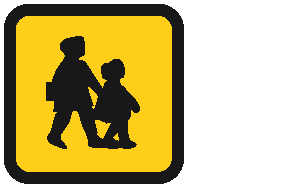
B
C
D
Correct Answer: A
Explanation: Buses carrying schoolchildren must display a distinctive yellow reflective sign on the front and rear, unless they're running a scheduled service for the general public. Buses displaying the sign are permitted to use hazard warning lights when they've stopped for schoolchildren to get on or off.
Explanation: Buses carrying schoolchildren must display a distinctive yellow reflective sign on the front and rear, unless they're running a scheduled service for the general public. Buses displaying the sign are permitted to use hazard warning lights when they've stopped for schoolchildren to get on or off.
31. You're parking your coach at a coastal resort. What should you do if your passengers will still have access to the vehicle?
Mark one answer
B
C
D
Correct Answer: C
Explanation: If passengers have access to your coach, it must never be left unattended. In particular, they mustn't be able to get into the cab area of the vehicle. You or another responsible person must always be there to supervise the coach.
Explanation: If passengers have access to your coach, it must never be left unattended. In particular, they mustn't be able to get into the cab area of the vehicle. You or another responsible person must always be there to supervise the coach.
32. What should you be especially aware of while you're driving a double-deck bus on a road with a steep camber?
Mark one answer

B
C
D
Correct Answer: A
Explanation: When driving high-sided vehicles, such as double-deck buses, changes in the road camber can affect your vehicle. As the bus leans towards the kerb, there's a risk that shop awnings, trees and street furniture, such as lampposts, could strike the top deck.
Explanation: When driving high-sided vehicles, such as double-deck buses, changes in the road camber can affect your vehicle. As the bus leans towards the kerb, there's a risk that shop awnings, trees and street furniture, such as lampposts, could strike the top deck.
33. What's the likely weight difference between an empty bus and a bus with 75 passengers on board?
Mark one answer
B
C
D
Correct Answer: D
Explanation: Your vehicle will handle very differently when it's full, compared with when it's empty. Having 75 passengers on board would increase the weight of the bus by about 5 tonnes - and the passengers may also have luggage. It will take longer to build up speed and the vehicle will be more difficult to stop. Forward planning and controlled braking will be required to allow for this extra weight.
Explanation: Your vehicle will handle very differently when it's full, compared with when it's empty. Having 75 passengers on board would increase the weight of the bus by about 5 tonnes - and the passengers may also have luggage. It will take longer to build up speed and the vehicle will be more difficult to stop. Forward planning and controlled braking will be required to allow for this extra weight.
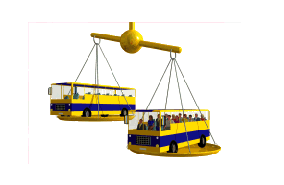
B
C
D
Correct Answer: B
Explanation: You should also make allowances for any luggage your passengers may bring on board. An average of two cases per passenger on a 50-seat coach will add about 1.5 tonnes to the overall weight of your bus or coach.
Explanation: You should also make allowances for any luggage your passengers may bring on board. An average of two cases per passenger on a 50-seat coach will add about 1.5 tonnes to the overall weight of your bus or coach.
B
C
D
Correct Answer: C
Explanation: Vehicles carrying schoolchildren display the 'school bus' sign to alert other drivers to the danger of children crossing the road. As the bus driver, you must make every effort to ensure the children's safety when boarding or getting off your bus, as well as during their journey with you.
Explanation: Vehicles carrying schoolchildren display the 'school bus' sign to alert other drivers to the danger of children crossing the road. As the bus driver, you must make every effort to ensure the children's safety when boarding or getting off your bus, as well as during their journey with you.
Correct Answer: D
Explanation: If exhaust fumes are getting into the vehicle, this could be a danger to your passengers. Stop as soon as it's safe to do so and have the fault put right before continuing.
Explanation: If exhaust fumes are getting into the vehicle, this could be a danger to your passengers. Stop as soon as it's safe to do so and have the fault put right before continuing.
37. What do you have to be aware of when driving a double-deck bus on a road that has a steep camber?
Mark one answer
B
C
D
Correct Answer: C
Explanation: A road that has a steep camber will slope sharply towards the kerb, causing your bus to lean towards the pavement or verge. This brings a risk of collision with objects such as overhanging trees, lampposts and bus-stop roofs.
Explanation: A road that has a steep camber will slope sharply towards the kerb, causing your bus to lean towards the pavement or verge. This brings a risk of collision with objects such as overhanging trees, lampposts and bus-stop roofs.
Correct Answer: A
Explanation: Always show consideration to passengers, whether they have special needs or not. Try to imagine what assistance you would like if you were in their position.
Explanation: Always show consideration to passengers, whether they have special needs or not. Try to imagine what assistance you would like if you were in their position.
39. Your bus is fitted with lifts or ramps for less mobile passengers. Who should operate this equipment?
Mark one answer
B
C
D
Correct Answer: C
Explanation: Make sure that you're fully trained in the safe use of lifts, ramps and securing devices. If you drive a vehicle fitted with this equipment, never let untrained people operate it.
Explanation: Make sure that you're fully trained in the safe use of lifts, ramps and securing devices. If you drive a vehicle fitted with this equipment, never let untrained people operate it.
Correct Answer: A
Explanation: Kneeling buses are equipped with air or hydraulic systems that allow the vehicle body to be lowered. This improves access for disabled and elderly passengers. Remember to return the mechanism to its travelling position before moving off.
Explanation: Kneeling buses are equipped with air or hydraulic systems that allow the vehicle body to be lowered. This improves access for disabled and elderly passengers. Remember to return the mechanism to its travelling position before moving off.
41. Your double-deck bus breaks down on a busy road. Where should you ask your passengers to move to?
Mark one answer
B
C
D
Correct Answer: A
Explanation: The greatest risk to a stationary bus is being hit from behind. Moving your passengers forward could reduce the risk of injury if such a collision occurred.
Explanation: The greatest risk to a stationary bus is being hit from behind. Moving your passengers forward could reduce the risk of injury if such a collision occurred.
Correct Answer: A
Explanation: Even though you've started to drive away, passengers may still try to get off the bus. You should also check your nearside mirror for any passengers trying to get on as you're moving away.
Explanation: Even though you've started to drive away, passengers may still try to get off the bus. You should also check your nearside mirror for any passengers trying to get on as you're moving away.
Correct Answer: B
Explanation: On regular services, traffic congestion can soon put you behind schedule. Nevertheless, you have a responsibility to your passengers at all times not to take shortcuts or jeopardise their safety; for example, by driving off while you're still issuing tickets.
Explanation: On regular services, traffic congestion can soon put you behind schedule. Nevertheless, you have a responsibility to your passengers at all times not to take shortcuts or jeopardise their safety; for example, by driving off while you're still issuing tickets.
44. Your bus breaks down on the motorway. What should you do if it isn't feasible to remove your passengers from the vehicle?
Mark one answer
B
C
D
Correct Answer: A
Explanation: Stop as far to the left as possible on the hard shoulder. Make sure all your passengers have moved as far as possible to the front of the vehicle; this will reduce the risk of injury if a passing vehicle runs into the back of the bus. Use an emergency telephone to call for assistance.
Explanation: Stop as far to the left as possible on the hard shoulder. Make sure all your passengers have moved as far as possible to the front of the vehicle; this will reduce the risk of injury if a passing vehicle runs into the back of the bus. Use an emergency telephone to call for assistance.
Correct Answer: D
Explanation: Bus drivers have responsibilities beyond those of other drivers. Your passengers have paid for a service, and they should arrive at their chosen destination safely. Customers are more likely to travel with you again if they receive a safe, courteous and comfortable service.
Explanation: Bus drivers have responsibilities beyond those of other drivers. Your passengers have paid for a service, and they should arrive at their chosen destination safely. Customers are more likely to travel with you again if they receive a safe, courteous and comfortable service.
46. You're driving a one-person-operated bus. What should you do while issuing tickets at a bus stop?
Mark one answer
B
C
D
Correct Answer: A
Explanation: Giving wrong signals causes uncertainty and confusion to other road users. Only give signals that are relevant and timed to match your actions.
Explanation: Giving wrong signals causes uncertainty and confusion to other road users. Only give signals that are relevant and timed to match your actions.
47. You're the driver of a one-person-operated double-deck bus. How do you stay aware of passengers on the top deck?
Mark one answer
B
C
D
Correct Answer: D
Explanation: If you're driving a one-person-operated double-deck bus, you must make sure that you use your internal mirrors. You need to be able to see passengers who are about to descend the stairs. Consider their safety and avoid harsh braking and steering.
Explanation: If you're driving a one-person-operated double-deck bus, you must make sure that you use your internal mirrors. You need to be able to see passengers who are about to descend the stairs. Consider their safety and avoid harsh braking and steering.
48. You're driving a double-deck bus. Why do you need to know if anyone is using the stairs?
Mark one answer
B
C
D
Correct Answer: B
Explanation: You must always be aware of anyone using the stairs. Be particularly careful to avoid any sudden movement, such as when braking or cornering, as this could cause passengers to stumble.
Explanation: You must always be aware of anyone using the stairs. Be particularly careful to avoid any sudden movement, such as when braking or cornering, as this could cause passengers to stumble.
B
C
D
Correct Answer: D
Explanation: If passengers aren't waiting at the bus stop, it can be tempting to stop near where they're standing. This may not be a safe place for your vehicle or for other road users. Be professional and be safe; stop in the correct position.
Explanation: If passengers aren't waiting at the bus stop, it can be tempting to stop near where they're standing. This may not be a safe place for your vehicle or for other road users. Be professional and be safe; stop in the correct position.
50. Where should you stop to make it easy for passengers leaving or joining your bus?
Mark one answer
B
C
D
Correct Answer: B
Explanation: You should stop as close to the kerb as you can, so that passengers can reach the safety of the pavement without any difficulty.
Explanation: You should stop as close to the kerb as you can, so that passengers can reach the safety of the pavement without any difficulty.
51. A bus stop is blocked and you can't get into it. What's the most important thing you should do before opening the exit door?
Mark one answer
B
C
D
Correct Answer: B
Explanation: Make sure that you allow your passengers to get on or off the vehicle safely. If you're unable to stop close to the kerb, don't open the doors until you're sure it's safe. You must take care of your passengers at all times.
Explanation: Make sure that you allow your passengers to get on or off the vehicle safely. If you're unable to stop close to the kerb, don't open the doors until you're sure it's safe. You must take care of your passengers at all times.
52. Several parked cars are blocking your bus stop. What should you do before allowing passengers to leave the bus?
Mark one answer
B
C
D
Correct Answer: A
Explanation: Always check your nearside mirror before opening the door to allow passengers to alight. When you've stopped away from the kerb, it's important to warn the passengers to look out for cyclists and to expect a long step down onto the road. Be ready to offer help if they need it.
Explanation: Always check your nearside mirror before opening the door to allow passengers to alight. When you've stopped away from the kerb, it's important to warn the passengers to look out for cyclists and to expect a long step down onto the road. Be ready to offer help if they need it.
Correct Answer: C
Explanation: Passenger safety is your main responsibility. Before you allow them to step down from the bus, you should always check your mirrors to make sure there's nothing approaching that could endanger them.
Explanation: Passenger safety is your main responsibility. Before you allow them to step down from the bus, you should always check your mirrors to make sure there's nothing approaching that could endanger them.
54. Passengers may be in a hurry to get off the bus as you approach a bus stop. What should you do to reduce any dangers?
Mark one answer
B
C
D
Correct Answer: B
Explanation: Passengers may have left their seats early and may be standing up, waiting to get off. Don't brake harshly or open the doors until the vehicle has stopped.
Explanation: Passengers may have left their seats early and may be standing up, waiting to get off. Don't brake harshly or open the doors until the vehicle has stopped.
55. When can you drive a bus at night without having the interior lights switched on?
Mark one answer
B
C
D
Correct Answer: C
Explanation: Whenever passengers are on board, the interior lighting must be left on. It may be turned off when the bus is empty.
Explanation: Whenever passengers are on board, the interior lighting must be left on. It may be turned off when the bus is empty.
56. You're driving a bus in hot weather. Can the passenger door be left open to let in fresh air?
Mark one answer
B
C
D
Correct Answer: A
Explanation: Under no circumstances should you drive with your passenger door open. An open door invites people to make rash decisions to enter or leave the vehicle as you're about to move away; this can be extremely dangerous.
Explanation: Under no circumstances should you drive with your passenger door open. An open door invites people to make rash decisions to enter or leave the vehicle as you're about to move away; this can be extremely dangerous.
Correct Answer: C
Explanation: Air suspension will increase passenger comfort and can also help to reduce wear on road surfaces - which is why it's also known as 'road-friendly suspension'.
Explanation: Air suspension will increase passenger comfort and can also help to reduce wear on road surfaces - which is why it's also known as 'road-friendly suspension'.
58. A disabled person is getting on your bus. What should you do if they're having problems, but say they can manage?
Mark one answer
B
C
D
Correct Answer: D
Explanation: Disabled people like to keep their independence. However, if they're having problems, be prepared to offer help.
Explanation: Disabled people like to keep their independence. However, if they're having problems, be prepared to offer help.
Correct Answer: C
Explanation: To prevent drivers from becoming distracted, TV or video equipment must be out of their sight. While passengers are being entertained, they can be sure the driver is concentrating on delivering them safely to their destination.
Explanation: To prevent drivers from becoming distracted, TV or video equipment must be out of their sight. While passengers are being entertained, they can be sure the driver is concentrating on delivering them safely to their destination.
Correct Answer: C
Explanation: All new buses and coaches must be easily accessible for disabled passengers. They must have ramps, priority seating and colour-contrasted fittings.
Explanation: All new buses and coaches must be easily accessible for disabled passengers. They must have ramps, priority seating and colour-contrasted fittings.
Correct Answer: C
Explanation: Since 2000, all new buses and coaches must be accessible to people with disabilities. These vehicles must have ramps, priority seating and colour-contrasted handrails and steps.
Explanation: Since 2000, all new buses and coaches must be accessible to people with disabilities. These vehicles must have ramps, priority seating and colour-contrasted handrails and steps.
62. A passenger using a wheelchair wants to get on your bus. When may you need to deny them access?
Mark one answer
B
C
D
Correct Answer: A
Explanation: It's unfortunate, but machinery will sometimes break down despite the best efforts to service it. Don't risk the health and safety of a person with a disability, or other passengers, by struggling to get them on without the proper equipment.
Explanation: It's unfortunate, but machinery will sometimes break down despite the best efforts to service it. Don't risk the health and safety of a person with a disability, or other passengers, by struggling to get them on without the proper equipment.
63. Your bus is accessible to wheelchair users. In what situation can you refuse to allow them access?
Mark one answer
B
C
D
Correct Answer: A
Explanation: It's illegal for bus and coach operators to discriminate against people with disabilities. You must always make reasonable adjustments to the way that any service is provided. This means that you must allow wheelchair users access to the designated space - unless it's already been taken by another wheelchair user.
Explanation: It's illegal for bus and coach operators to discriminate against people with disabilities. You must always make reasonable adjustments to the way that any service is provided. This means that you must allow wheelchair users access to the designated space - unless it's already been taken by another wheelchair user.
64. You're driving a school bus carrying children. When can you make physical contact with a passenger?
Mark one answer
B
C
D
Correct Answer: A
Explanation: All physical contact with children should be avoided except in specific circumstances such as genuine self-defence, a medical emergency, or to prevent a serious offence or threat to anyone's safety.
Explanation: All physical contact with children should be avoided except in specific circumstances such as genuine self-defence, a medical emergency, or to prevent a serious offence or threat to anyone's safety.
Correct Answer: C
Explanation: You should make yourself clearly visible when you're working outside your vehicle and close to moving traffic.
Explanation: You should make yourself clearly visible when you're working outside your vehicle and close to moving traffic.
66. You're about to drive on a route where you'll be picking up wheelchair users. What must be checked before leaving the depot?
Mark one answer
B
C
D
Correct Answer: A
Explanation: It's a legal requirement that you should make reasonable adjustments to provide for people with disabilities. You should make sure that any ramp or lift is in place and in good working order before leaving the depot.
Explanation: It's a legal requirement that you should make reasonable adjustments to provide for people with disabilities. You should make sure that any ramp or lift is in place and in good working order before leaving the depot.
Correct Answer: B
Explanation: You won't have failed in your statutory duties if the boarding device breaks down and there's no other means of assisting the passenger.
Explanation: You won't have failed in your statutory duties if the boarding device breaks down and there's no other means of assisting the passenger.
Correct Answer: A
Explanation: If a wheelchair space is occupied by standing passengers and luggage, you might not be able to allow a wheelchair user on the bus. This may occur on a bus that's almost full to capacity. You won't have failed in your statutory duties towards the wheelchair user.
Explanation: If a wheelchair space is occupied by standing passengers and luggage, you might not be able to allow a wheelchair user on the bus. This may occur on a bus that's almost full to capacity. You won't have failed in your statutory duties towards the wheelchair user.
69. You're at a bus stop. What should you do if passengers are standing on the open platform?
Mark one answer
B
C
D
Correct Answer: D
Explanation: A bus driver must never allow their passengers to ride on an open platform. Anyone standing on an open platform is at risk should the driver have to brake harshly, swerve or suddenly change direction.
Explanation: A bus driver must never allow their passengers to ride on an open platform. Anyone standing on an open platform is at risk should the driver have to brake harshly, swerve or suddenly change direction.




